 Hyundai Elantra HD: Condition and operation in the front passenger occupant classification system
Hyundai Elantra HD: Condition and operation in the front passenger occupant classification system
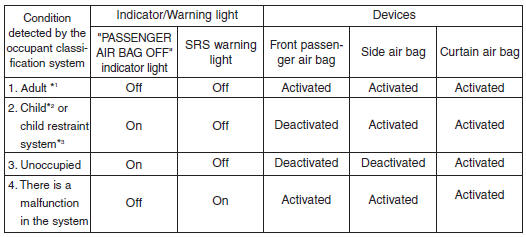
*1) The system judges a person of adult size as an adult. When a smaller adult
sits in the front passenger seat, the system may recognize him/her as a child depending
on his/her physique and posture.
*2) Do not allow children to ride in the front passenger seat. When a larger child
who has outgrown a child restraint system sits in the front passenger seat, the
system may recognize him/her as an adult depending on his/her physique or posture.
*3) Never install a child restraint system on the front passenger seat.
![]() WARNING
WARNING
Riding in an improper position or placing weight on the front passenger's seat when it is unoccupied by a passenger adversely affects the occupant classification system (OCS).
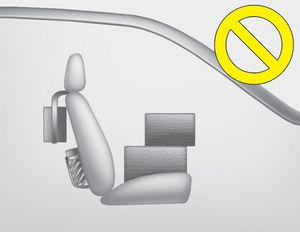
- Never put a heavy load in the front passenger seat or seatback pocket.
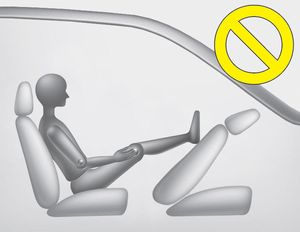
- Never place feet on the front passenger seatback.
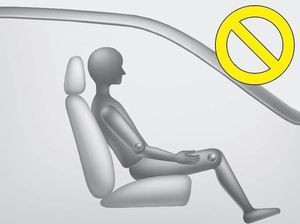
- Never sit with hips shifted towards the front of the seat.
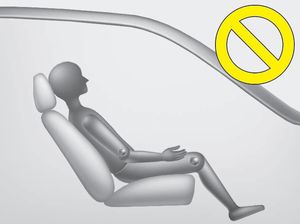
- Never excessively recline the front passenger seatback.
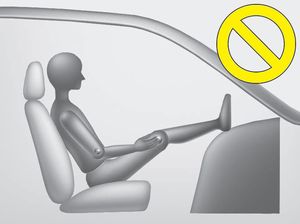
- Never place feet on the dashboard.
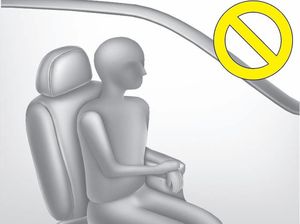
- Never lean on the center console.
- Never sit on one side of the front passenger seat.
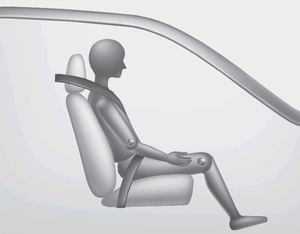
Proper position
When an adult is seated in the front passenger seat, if the "PASSENGER AIR BAG OFF" indicator is on, turn the ignition key to "LOCK" and ask the passenger to sit properly (sitting upright with the seat back in an upright position, centered on the seat cushion with their seat belt on, legs comfortably extended and their feet on the floor). Restart the engine and have the person remain in that position. This will allow the system to detect the person and to enable the passenger air bag.
If the "PASSENGER AIR BAG OFF" indicator is still on, ask the passenger to move to the rear seat.
![]() WARNING
WARNING
Do not allow an adult passenger to ride in the front seat when the “PASSENGER AIR BAG OFF” indicator is illuminated, because the air bag will not deploy in the event of a crash. If the "PASSENGER AIR BAG OFF" indicator remains illuminated after the passenger repositions themselves properly and the car is restarted, we recommend that passenger move to the rear seat because the passenger's front air bag will not deploy.
Front seat passengers must stay properly seated to avoid serious injury from a deploying air bag.
✽ NOTICE
The "PASSENGER AIR BAG OFF" indicator illuminates for about 4 seconds after the ignition key is turned to the "ON" position or after the engine is started. If the front passenger seat is occupied, the occupant classification sensor will then classify the front passenger after several more seconds.
![]() WARNING
WARNING
Do not put a heavy load in the front passenger seatback pocket or on the front passenger seat. Do not hang onto the front passenger seat. Do not hang any items such as seatback table on the front passenger seatback. Do not place feet on the front passenger seatback. Do not place any items under the front passenger seat. Any of these could interfere with proper sensor operation.
![]() WARNING
WARNING
If the occupant classification system is not working properly, the SRS air bag
warning light  on the instrument panel
will illuminate because the passenger's front air bag is connected with the occupant
classification system. If there is a malfunction of the occupant classification
system, the "PASSENGER AIR BAG OFF" indicator will not illuminate and the passenger's
front air bag will inflate in frontal impact crashes even if there is no occupant
in the front passenger's seat. If the SRS air bag warning light does not illuminate
when the ignition key is turned to the "ON" position, remains illuminated after
approximately 6 seconds when the ignition key is turned to the "ON" position, or
if it illuminates while the vehicle is being driven, have an authorized Hyundai
dealer inspect the occupant classification system and the SRS air bag system as
soon as possible.
on the instrument panel
will illuminate because the passenger's front air bag is connected with the occupant
classification system. If there is a malfunction of the occupant classification
system, the "PASSENGER AIR BAG OFF" indicator will not illuminate and the passenger's
front air bag will inflate in frontal impact crashes even if there is no occupant
in the front passenger's seat. If the SRS air bag warning light does not illuminate
when the ignition key is turned to the "ON" position, remains illuminated after
approximately 6 seconds when the ignition key is turned to the "ON" position, or
if it illuminates while the vehicle is being driven, have an authorized Hyundai
dealer inspect the occupant classification system and the SRS air bag system as
soon as possible.
![]() WARNING
WARNING
- Even though your vehicle is equipped with the occupant classification system, never install a child restraint system in the front passenger's seat. A deploying air bag can forcefully strike a child resulting in serious injuries or death. Any child age 12 and under should ride in the rear seat. Children too large for child restraints should use the available lap/shoulder belts. No matter what type of crash, children of all ages are safer when restrained in the rear seat.
- If the "PASSENGER AIR BAG OFF" indicator is illuminated when the front passenger's seat is occupied by an adult and he/she sits properly (sitting upright with the seatback in an upright position, centered on the seat cushion with their seat belt on, legs comfortably extended and their feet on the floor), have that person sit in the rear seat.
- Do not modify or replace the front passenger seat. Don't place anything on or attach anything such as a blanket or after market seat heater to the front passenger seat.This can adversely affect the occupant classification system.
- Do not sit on sharp objects such as tools when occupying the front passenger seat. This can adversely affect the occupant classification system.
- Do not use accessory seat covers on the front seats.
- Accident statistics show that children are safer if they are restrained in the rear, as opposed to the front seat. It is recommended that child restraints be secured in a rear seat, including an infant riding in a rear-facing infant seat, a child riding in a forward- facing child seat and an older child riding in a booster seat.
- Air bags can only be used once – have an authorized Hyundai dealer replace the air bag immediately after deployment.
- A smaller-stature adult who is not seated correctly (for example: seat excessively reclined, leaning on the center console, or hips shifted forward in the seat) can cause a condition where the advanced frontal air bag system senses less weight than if the occupant were seated properly (sitting upright with the seatback in an upright position, centered on the seat cushion with their seat belt on, legs comfortably extended and their feet on the floor). This condition can result in an adult potentially being misclassified and illumination of the "PASSENGER AIR BAG OFF" indicator.


